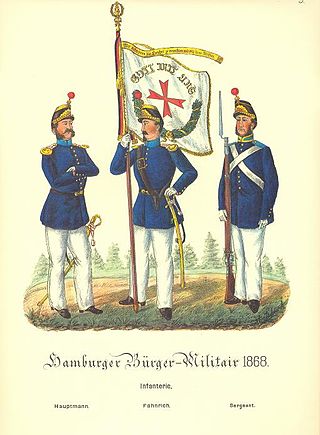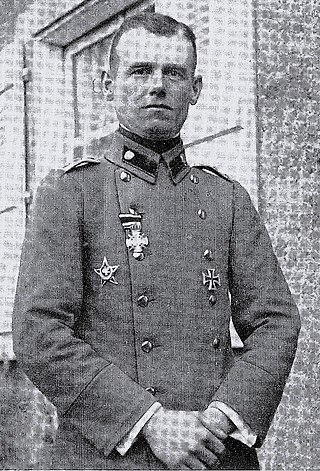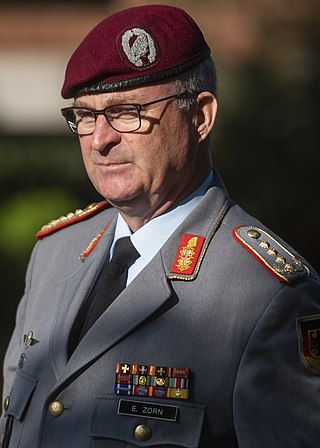
Idar-Oberstein is a town in the Birkenfeld district in Rhineland-Palatinate, Germany. As a Große kreisangehörige Stadt, it assumes some of the responsibilities that for smaller municipalities in the district are assumed by the district administration. Today's town of Idar-Oberstein is the product of two rounds of administrative reform, one in 1933 and the other in 1969, which saw many municipalities amalgamated into one. The various Stadtteile have, however, retained their original identities, which, aside from the somewhat more urban character encountered in Idar and Oberstein, tend to hark back to each centre's history as a rural village. Idar-Oberstein is known as a gemstone town, and also as a garrison town. It is also the largest town in the Hunsrück.

Baumholder is a town in the Birkenfeld district in Rhineland-Palatinate, Germany, in the Westrich, an historic region that encompasses areas in both Germany and France. The town of Baumholder is the administrative seat of the like-named Verbandsgemeinde, a state-recognised tourism resort and, according to state planning, a middle centre.

Kraft Prinz zu Hohenlohe-Ingelfingen was a Prussian general and military writer during the time of the German Empire.

Frederick II was the last sovereign Grand Duke of Baden, reigning from 1907 until the abolition of the German monarchies in 1918. The Weimar-era state of Baden originated from the area of the Grand Duchy of Baden.
The 1st Division was a unit of the Prussian/German Army. It was formed in Königsberg in March 1816 as a Troop Brigade (Truppen-Brigade). It became the 1st Division on September 5, 1818. From the corps' formation in 1820, the division was subordinated in peacetime to I Army Corps. The 1st Division was disbanded in 1919, during the demobilization of the German Army after World War I.
The 2nd Division was a unit of the Prussian/German Army. It was formed in Danzig in March 1816 as a Troop Brigade (Truppen-Brigade). It became the 2nd Division on September 5, 1818. In 1890, the headquarters of the division was relocated to Königsberg, then the capital of East Prussia. In 1899, the headquarters was moved to Insterburg, further inland and closer to the border with the Russian Empire. From the latter's formation in 1820, the division was subordinated in peacetime to the I Army Corps. The 2nd Division was disbanded in 1919 during the demobilization of the German Army after World War I.

The XVIII Army Corps / XVIII AK was a corps level command of the German Army before and during World War I.

The XII Army Corps / XII AK was a Saxon corps level command of the Saxon and German Armies before and during World War I.

The 39th Division was a unit of the Prussian/German Army. It was formed on April 1, 1899, and headquartered in Colmar. The division was subordinated in peacetime initially to the XIV Army Corps and later to the XV Army Corps. The division was disbanded in 1919 during the demobilization of the German Army after World War I.

The Hamburg Citizen Militia or Hanseatic Citizen Guard was a citizen militia of the Free and Hanseatic City of Hamburg, formed from conscripted citizens and inhabitants of the city. It was formed in 1814 and dissolved in 1868.

Egon Ramms is a retired German general who held numerous international commands. Ramms is a father of two.
Johannes Block was a German general in the Wehrmacht during World War II who held commands at division and corps level. He was a recipient of the Knight's Cross of the Iron Cross with Oak Leaves. Block was killed on 26 January 1945 near Kielce, Poland during the Soviet Vistula-Oder Offensive.
Heribert von Larisch was a German general during World War II. He was a recipient of the Knight's Cross of the Iron Cross.
The Army Training Centres, together with the Army Training Schools, form the training establishments of the German Army within the Bundeswehr. They are subordinated to the German Army Office (Heeresamt). Several are not (exclusively) charged with training, but are also support establishments that, e. g. are responsible for Army logistics or the maintenance and operations of training facilities, including the military training areas. The distinction between training centres and schools or arms schools in the Army is sometimes blurred. For example, many centres that are charged with basic and continuation training for an arm or service are run by a general who is the head of arm, such as the General of the Armoured Corps.
The Central Army Group (CENTAG) was a NATO military formation comprising four Army Corps from two NATO member nations comprising troops from Canada, West Germany and the United States. During the Cold War, CENTAG was NATO's forward defence in the southern half of the Federal Republic of Germany (FRG). The northern half of the FRG was defended by the four Army Corps of NATO's Northern Army Group (NORTHAG). During wartime, CENTAG would command four frontline corps. Air support was provided by Fourth Allied Tactical Air Force.

Willy Martin Ernst Rohr was a German Army officer who was a major contributor to the development of infantry tactics in World War I, particularly for the system of Storm Battalions.
The following lists German active and reserve units within the structure of the German Army. Reserve units do not possess any heavy equipment and their personnel is intended as replacements for losses sustained by regular units.

Eberhard Zorn is a retired German general who served as the 16th Inspector General of the Bundeswehr, the German Armed Forces.

Juliusz Alfred Drapella was a Polish brigadier general of the Polish Armed Forces who was most notable during his service in World War II.

Ottokar Wincenty Brzoza-Brzezina was a Polish brigadier general of Czech origin who was notable for his service in the Battle of Krzywopłoty during the First World War.












